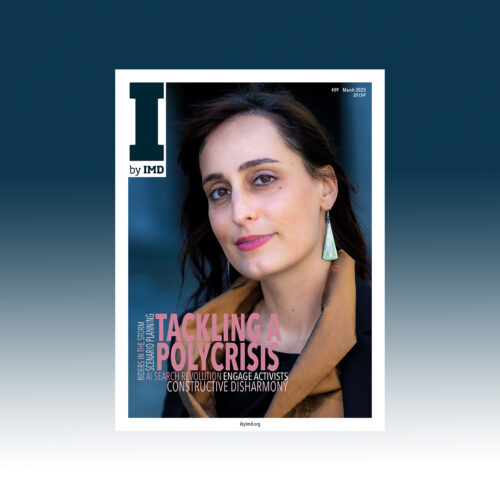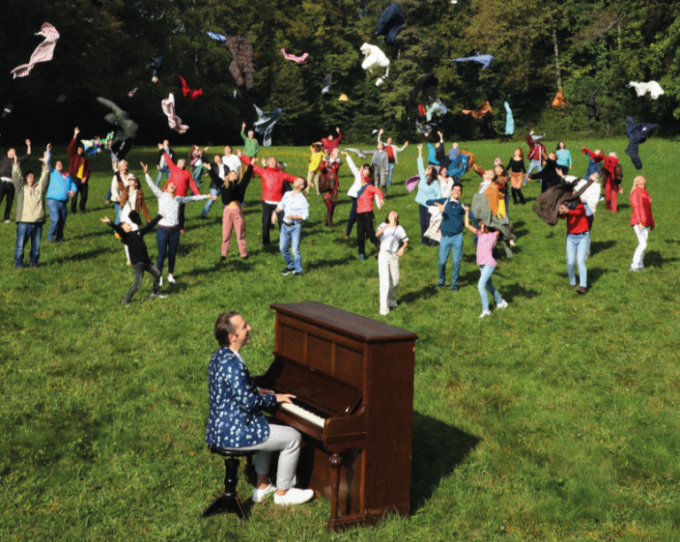Audio articles
Business Leaders
The ins and outs of good breathing and better communication
21 April 2023 • by Albrecht Enders in Audio articles
Vocal leadership consultant Robin De Haas explains to Albrecht Enders how executives can achieve greater influence and avoid miscommunication by learning to coordinate the muscles involved in breathing and creating sounds....
Vocal leadership consultant Robin De Haas explains to Albrecht Enders how executives can achieve greater influence and avoid miscommunication by learning to coordinate the muscles involved in breathing and creating sounds.
Born with a cleft palate, Robin De Haas had a speech impediment so severe that he could pronounce neither consonants nor vowels. Bullied and beaten at school, by the tender age of eight he thought about ending his life. Thirty years later, he is a vocal coach to the stars. He works all over the world training singers, both classical and pop, and senior executives on how to better co-ordinate their breathing muscles to create optimal sounds. So how did he get there?
The game changer for De Haas came when he realized that overcoming his own challenges could be a way to help others.
“This research into my voice became a sense of, ‘How can I help others shine?’ And when I do that, whether it be with an executive, an opera singer, or with a person with long COVID … when I see them uncover the untapped potential that their body has to offer them, and I see their smile, or I see them on stage – that’s when I get goosebumps, that’s when I get tears. Because I feel somehow profoundly reassured that if I’ve helped someone, my inner child is each time symbolically stepping further away from getting beaten up again.”

New approaches to dealing with challenges
Tackling a polycrisis
Geopolitical tensions, persistent inflation, economic weakness, climate change, and sustainability. Business leaders are dealing with an unprecedented range of challenges simultaneously, making it harder than ever to know how to prioritize, navigate, and communicate effectively with teams. Scenario planning, listening and leading in new ways are part of the answer. In Issue IX of I by IMD, we unpack new approaches to dealing with the polycrisis that's facing us.
De Haas, who was the subject of a movie made about his life, believes that many people underestimate the power of their breath in managing their state of mind and using their voice. A disciple of Lynn Martin, a distinguished professor of functional anatomy and body management at New York University, his breathing coordination method is based on the work of Carl Stough, an American choral conductor and breathing specialist who founded an eponymous breathing institute.
De Haas’s work involves understanding how the sympathetic autonomic nervous response system – which stimulates the body’s fight-or-flight mech-anism in response to dangerous or stressful situations – impacts our breathing.
“We all know that when we’re scared our breathing changes. Say, for instance, if I hide behind a door and jump out on you, you’re going to do a short-pulled inhale,” he said.
While many executives are aware that they need to pay attention to their hand gestures and facial expressions as well as their words when communicating, very few realize the power of their voice and breath in building trust with employees and soliciting honest input from others.- Robin de Haas
Although we no longer have to hunt for our food, the evolution of our fight-or-flight system has not kept pace. In short, the reaction of our breath whenever we get stressed or upset is as if we have seen a predator, explained De Haas. As humans, we are attuned to these micro-movements in others – just like an antelope that hasn’t yet spot-ted a predator but has learned to recognize that danger is imminent if others in the herd suddenly take flight.
Your inner antelope
So how does this play out in the workplace? Imagine you’ve had a stressful morning. Your child chokes on their breakfast or throws up on your favorite shirt. This kind of situation will likely trigger your sympathetic autonomic nervous response system. Your breathing will get faster, your bronchial tubes will widen, and your pulmonary blood vessels will narrow.
After you leave the house, you may still be operating in this fight- or-flight mode, because – in the absence of a physical predator – your body doesn’t know when to turn it off, and thoughts or worries about your child might keep it active. When you’re speaking to your team, it’s likely that they will subconsciously pick up on this stress, De Haas says.
“They might think you’re upset with them; they might think you’re unhappy with their results, or they might just feel it without even knowing exactly why, because their inner antelopes want to run away,” he explained.
“They’re listening to you, but subconsciously they’re analyzing the movement in your chest. They’re analyzing your breathing pattern because their nervous system tells them that they need to analyze it, to check whether there is a predator. But because of that, they might also think that you’re not telling them the truth. So it leads to a whole set of misunderstandings.”
While many executives are aware that they need to pay attention to their hand gestures and facial expressions as well as their words when communicating, very few realize the power of their voice and breath in building trust with employees and soliciting honest input from others.

Breath management is also important when speaking to large groups of people. A lack of control may cause your voice to crack and lack resonance. If you are stressed, your shallow breathing may make you feel even more nervous and cause you to speak faster. So, while your hand gestures might be positive and open, if your chest is raised up, your ribcage locked, and your breathing blocked, you are not going to be congruent.
“True leadership comes from within,” said De Haas. “It comes from your organ column. It comes from being aligned with your values and how you read the world. But you cannot do it if you are in fight-or-flight response. In my experience, the fastest and most reliable way to get out of fight-or-flight is through coordinating the breath.”
When in doubt, breathe out
In today’s world of multiple crises and fast-paced digital change, De Haas believes breath coordination is a critical part of a leader’s toolkit.
“When you look at the failure of companies to understand disruptive change, I do wonder if it’s not also caused by a culture of fight-or-flight where people are much narrower in their mind than they need to be,” he said.
So, what can executives do to gain greater coordination of their breath?
De Haas believes there is still a lack of clarity around what constitutes good breathing. An online search for “correct breathing” mostly brings up items instructing you to take a deep breath in by inflating the stomach.
True leadership comes from within … it comes from being aligned with your values and how you read the world. But you cannot do it if you are in fight-or-flight response. The fastest and most reliable way to get out of fight-or-flight is through coordinating the breath.- Robin de Haas
In fact, says De Haas, the trick is to focus on the exhale and strive for a small and steady outflow of air. “This is what triggers efficient use of voice. It also triggers efficient use of the nervous system because it helps to tell it that we are not in a place where there is actually danger.”
For those looking for examples of great speakers who get it right, he suggests watching videos of Martin Luther King. “If you look at his ‘I Have a Dream’ speech – and of course, it’s for thousands of people, so the movements are quite big – but if you look at the breathing patterns and the way to use the voice, he basically does everything in a textbook way.”
Becoming more conscious of your breathing will not only calm your mind and help you think more clearly but can also help you to gain greater influence. De Haas describes how he worked with a top official at the United Nations who was experiencing high turnover of assistants and bodyguards because he didn’t know how to handle the coordination between his breathing and his voice.
“After about four sessions, I went in and his staff stopped me and asked, What have you done with him? He’s no longer screaming at us.”
After De Haas had worked with him, the official gave a speech in front of national representatives asking for money to fund the agency. “And you know what they told him? They said, ‘What you were asking for this year was so much more important than two years ago’. But it was the same speech as before. And they actually gave him much more money. He called me and kept repeating: ‘This is a miracle, this is a miracle.’ That shows that this is key.”
Breathing exercises for executives
To optimize your voice, it’s important to allow every part of the breathing mechanism to move, including the individual muscles in the rib cage. You need to focus on exhaling comfortably and completely in order to maintain the mobility of the breathing apparatus and calm the nervous system. While we might all be tempted to take a big breath before launching into a speech, paradoxically breathing in calmly when you speak leads to a better sound. What executives should be aiming for is “minimum effort, maximum efficiency”.
Here are a couple of things to try:
- Before taking the stage or beginning a difficult conversation, lie on your back and focus on a complete exhale, without unduly tensing any muscle group. Do this for as long as is comfortable and follow with a quiet inhale.
- While in a meeting, use the time when someone is asking a question to think of a passive inhale, and use the time when writing on the flip chart to focus on the exhale.
Experts

Robin de Haas
Vocal leadership consultant
Robin de Haas is a Swiss pedagogue and vocal consultant. He is known for his method of respiratory coordination, which particularly benefits singers and sportsmen.
Authors

Albrecht Enders
Professor of Innovation and Strategy at IMD
Albrecht Enders is Professor of Strategy and Innovation at IMD and co-director of the Transition of Business Leadership program, and the Complex Problem Solving. His major research, teaching, and consulting interests are in the areas of managing discontinuous change and top-team strategy development processes. Before joining IMD, Professor Enders spent three years as a consultant with The Boston Consulting Group in Cologne where he worked on projects in the areas of financial services, energy, and industrial goods.
